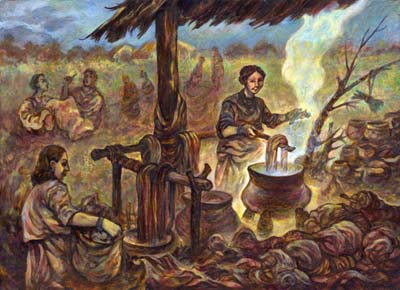Textile
Textile that was made by weaving and knitting in every settlement of any period is hard to confirm archeologically. Still, there are sporadic finds of objects that indirectly tell of the manufacture of textile and of its appearance.
Relatively numerous spinning-wheel disks testify to knitwear photo 116, 117, 166, 34, 35, 36, 93, and they can be found in the structures from the Classical period and the 6th century. They are of various appearances, made of fresh clay and baked or of pottery sherds by secondary processing. Those from the late Ancient period are more varied in shape and decoration, while those from the 1st and 6th century were quite uniform. Indirect proof of knitwear, that is of the manufacture of wool, are sheep shears photo 65 from the 1st century, as well as very numerous sheep bones in osteological material. Combs for combng wool as another indirect proof of the existence of knitted objects were found in a house from the 9th-10th century. photo 178.
Picture 2/2: Sheep shearing and slaughtering of calfWeaving was confirmed by finds of loom weights photo 164 from the 6th century which are of conical shape with a circular opening for tying. On some of them there is a clearly visible trace of the rope they were tied with, thus hanging and serving to stretch tight the base of the loom. The weights from the 1st century which were of tubular and pyramidal shape photo 37, are narrower in the middle, where traces of tying can also be seen, and were perhaps also used for looms. As opposed to those from the 6th century that were found in greater number in one house which testifies to their weaving purpose, those from the 1st century have not as yet been found in such a context.
Picture 2/6: Weaving on a simple loomThe most direct evidence of the appearance of the textiles can be found in imprints photo 12, 119, 174 on vessels, which are always on very small surfaces but sufficient to see the structure of the weaving. We can only assume that the fabrics were also dyed, although there is no direct evidence to this.
Picture 2/7: Dyeing of fabrics


